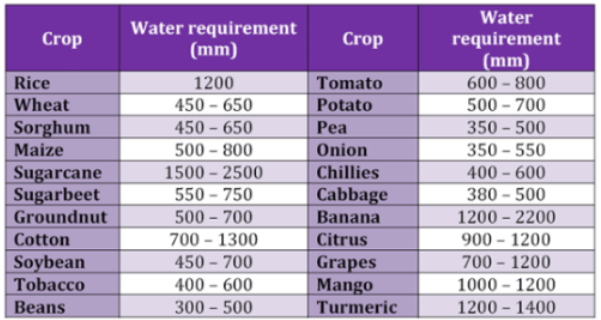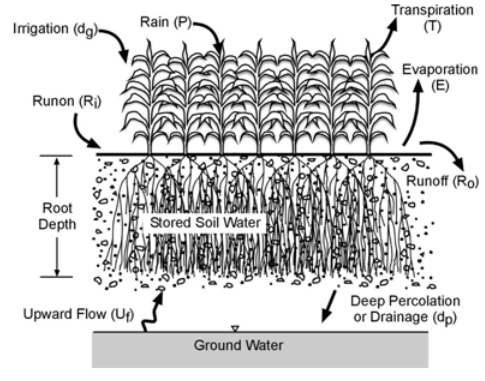Crop Water Requirement, Irrigation Engineering | Irrigation Engineering Notes - Agricultural Engineering PDF Download
Crop Water Requirement
It is defined as the total quantity of water required by a crop irrespective of its source in a given period of time for its normal growth and development under field conditions at a given place. In means that it is the total quantity of water required to mature an adequately irrigated crop to meet the losses due to evapotran spiration (ET), plus the losses during the application of irrigation water (unavoidable losses) and the additional quantity of water required for special operations such as land preparation, transplanting, leaching of salts below the crop root zone, frost control etc. It is expressed in depth per unit time.
 (26.1)
(26.1)
In other words, crop water requirement is total water demand for growing a crop. Crop water demand can also be expressed in term of supply as:
WR = IRR + ER +ΔS +GWC (26.2)
Where:
WR = Total depth of water required during the life of crop irrespective of source
CU = Consumptive use (total water required for all plant processes)
ER = Effective rainfall received during crop life
ΔS = Profile water use i.e., difference in soil moisture in the crop root zone at the beginning and end of the crop
GWC= Groundwater contribution, if any
IRR = Irrigation
In the previous lecture crop ET estimation procedure based on reference crop ET and crop coefficient approach is described. A number of methods are available for estimation of reference crop ET (ETo) using the weather data. However, crop ET can also be measured using the field water balance or lysi meter. These methods are laborious and time consuming and therefore, indirect methods of crop ET estimation are commonly used and will be covered in this lecture.
The term effective rainfall has a different meaning to different users. For example for hydrologist effective rainfall means runoff, whereas for irrigation engineers of agriculturist effective rainfall means useful or utilizable rainfall for the purpose of crop growth.
Dastane (1974) has defined effective rainfall as “that portion of the total annual or seasonal rainfall which is useful directly and/or indirectly for meeting the crop water needs in crop production at the site where it falls but without pumping”. Thus, it is the portion of rainfall that does not include losses due to surface runoff, unnecessary deep percolation and residual moisture after harvest. This concept of effective rainfall is suggested for use in planning and operation of irrigation projects. A number of factors affects effective rainfall include, rainfall characteristics, land topography, soil and crop characteristics, management practices, carryover moisture content and groundwater contribution. A number of methods are in practice for determining effective rainfall. These include, field water balance approach, drum culture approach for rice, and empirical relationship (SCS method).The water requirement of different crops are given in Table 26.1.
Table 26.1. Water requirement of different crops

26.1.1 Net Irrigation Requirement
The net irrigation requirement is the total amount of irrigation water required tobring the soil moisture content in the root zone depth of the crops to field capacity i.e., difference between the field capacity and the soil moisture content in the root zone before application of irrigation water. This may be obtained by the relationship given below:
 (26.3)
(26.3)
Where,
NIR = net amount of water to be applied during an irrigation, cm
Mfci = gravimetric moisture content at field capacity in the ith layer of the soil, (%)
Mbi = gravimetric moisture content before irrigation in the ith layer of the soil, (%)
ρbi = bulk density of the soil in the ith layer, g/cm3
Di = depth of the ith soil layer, cm, within the root zone, cm
N = number of soil layers in the root zone D.
26.1.2 Gross Water Requirement
The total amount of water, inclusive of losses, applied throughirrigation is termed as gross irrigation requirement which in other words in net irrigationrequirement plus application and other losses.
 (26.4)
(26.4)
26.1.3 Duty of Water (D)
This is defined as the area that can be irrigated with a continuous non-stopsupply of irrigation water at the rate of one cumec or cusec throughout the baseperiod. It is expressed as acre/cusec or hectare/cumec.
26.1.4 Base Period (B)
This is the period over which irrigation water is to be supplied for the production of any crop. Normally this is equal to the period between the first and last irrigation applied to acrop.
26.1.5 Delta (Δ)
This the depth of water required by a crop during the crop season to meet itsrequirements. This does not have any relevance to the area of the cropped field. It isexpressed in mm or cm.
Relationship between D, Δ and B
 (26.5)
(26.5)
Where, Δ in cm, B in days and D in ha/cumec.
26.2 Methods of Crop Water Requirement Determination
26.2.1 Direct Measurement of Evapo transpiration
Plant water use is an important management input, thus, it is critical to know ET.Several methods have been developed to measure evapotranspiration is already discussed earlier (see section 25.3), a few aresummarized here.
26.2.1.1 Aerodynamic Methods
The vapour pressure of the air and air flowvelocities can be measured at several levels above a plant canopy. By evaluating thesemeasurements, the instantaneous evapotranspiration rate can be determined. Summingthese instantaneous measurements provides an estimate of evapotranspiration for a day.This technique requires very accurate equipment because the air moves erratically abovethe canopy.
26.2.1.2 Soil Water Balance Methods
Soil water is the source for evapotranspiration, andseveral methods have been used to relate changes in soil water to plant water use. Theprimary components of the soil water balance are illustrated in Figure 26.1. The soil waterbalance can be expressed as:
 (26.6)
(26.6)
Where,
ET = amount of evapotranspiration during the period,
AWe = amount of soil water in the root zone at the end of a period,
AWb = amount of soil water in the root zone at the beginning of a period,
P = total precipitation during the period,
dg = gross irrigation during the period,
Uf = groundwater contribution to water use during the period,
Ri= surface water that runs onto the area during the period,
Ro = surface runoff that leaves the area during the period, and
dp = deep percolation from the root zone during the period.

Fig.26.1.Sketch illustrating the components of the soil water balance.
Soil water content can be measured using neutron scattering or other techniques described earlier. Deep percolation is difficult to measure and is often assumed to be insignificant unless substantial rainfall occurs or large irrigations are applied. A significant problem with the soil water balance technique is that repetitive measurements must be made throughout the season. One week is usually the shortest period for using the soil water balance method to estimate ET.
26.2.1.3 Lysimetry
Lysimetersare measuring device used for estimating evapotranspiration. It consists of specially designed open-top tanks buried in the field that are filled with undisturbed soil, and planted with the same crop as the surrounding area. Water used for ET by plants grown in the lysimeter must come from the soil water within the tank. ET can be measured by monitoring soil water contents and water applications from irrigation or rain. The soil tank is used to isolate soil water from the surrounding area and to prevent runoff, upward groundwater flow, and drainage entering into the system. For some applications drainage is allowed and the volume of deep percolation is measured. The soil water within the tank can be measured with traditional methods such as neutron probes. The amount of water in the tank can also be determined by weighing the tank, soil, plants, and soil water. Since soil water is the only item that changes significantly over short time periods, the change in weight equals the amount of water used for ET.

Fig.26.2. Cutaway drawing of weighing type lysimeter.
FAQs on Crop Water Requirement, Irrigation Engineering - Irrigation Engineering Notes - Agricultural Engineering
| 1. What is crop water requirement? |  |
| 2. What is irrigation engineering? |  |
| 3. How is crop water requirement calculated? |  |
| 4. Why is understanding crop water requirement important in agricultural engineering? |  |
| 5. How can agricultural engineering contribute to water conservation in irrigation? |  |





















